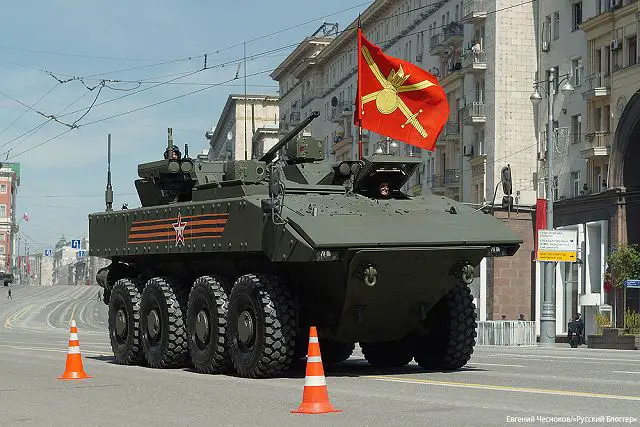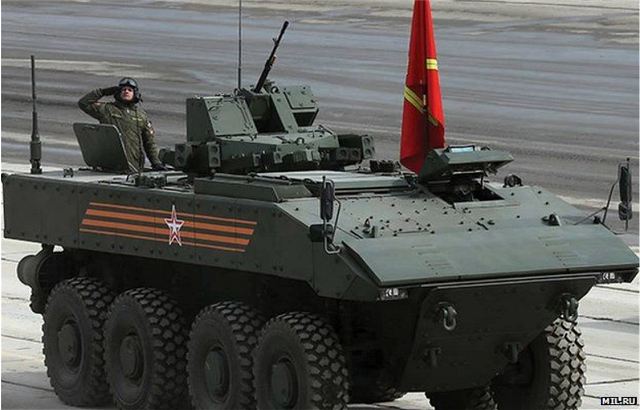|
|
|||
|
Military Defense Industry Technology - New Bumerang
|
|||
|
|
|||
| Russian land and naval forces will receive armoured vehicles derived from the Bumerang platform | |||
|
The Russian Army and Marine Corps may receive armored vehicles derived from the Bumerang commonized armored wheeled chassis, according to the Izvestia daily. The Military Industrial Company (VPK), which is the major manufacturer of armored personnel carriers (APC), infantry fighting vehicles (IFV) and armored cars for the Russian Armed Forces, has started the preliminary tests of an amphibious APC derived from the Bumerang.
|
|||
|
|
|||
 The K-17 Bumerang is an IFV (Infantry Fighting Vehicle) fitted with a an electrically powered unmanned turret mounted in the centre of the hull. The turret is armed with the 2A42 30mm automatic cannon. The K-17 Bumerang is an IFV (Infantry Fighting Vehicle) fitted with a an electrically powered unmanned turret mounted in the centre of the hull. The turret is armed with the 2A42 30mm automatic cannon. |
|||
|
|
|||
| According to Sergei Suvorov, spokesman for VPK LLC, the Bumerang will be a quantum leap in Soviet and Russian wheeled APC development, because it will be based on a common combat platform fit for use by both the Army and Marines. As was reported in the press, the advanced wheeled APC is slated for service entry in 2017. "Eight wheels are the only thing the Bumerang and in-service BTR-80 and BTR-82 armored personnel carriers have in common," Suvorov said. "In other respects, the Bumerang is an utterly different commonized platform designed for the inventories of the Army and Navy - the latter’s Marine Corps in particular." According to Suvorov, a problem of the BTR-80 family is its relatively low protection against landmines and improvised explosive devices. Therefore, troops prefer to ride the APCs on top, rather than inside. The low mine protection was among the causes of the advanced APC’s development. The Bumerang was unveiled to the public on May 9, 2015. Its key feature is modularity, i.e. the ability to spawn a whole family of combat vehicles based on the same chassis. The Bumerang’s derivatives include the K-16 APC and K-17 IFV. This allows the platform to be offered to virtually any Russian uniformed service, be it the Army, National Guard or Marines. |
|||
|
|
|||
 The K-16 Bumerang is an APC (Armoured Personnel Carrier) fitted with a small unmanned turret armed with a 12.5 mm heavy machine gun. The K-16 Bumerang is an APC (Armoured Personnel Carrier) fitted with a small unmanned turret armed with a 12.5 mm heavy machine gun. |
|||
|
|
|||
|
Expert Victor Murakhovsky says the Marines are like the Paras - a rapid reaction force. Under the plans drawn up in 2015, the Marines were to take delivery of T-90 tanks, BMP-3 IFVs, BTR-82A APCs, BRDM-3 armored scout vehicles, 120-mm 2S31 Vena self-propelled artillery systems, upgraded air defense weapons, small arms, rocket launchers and automatic grenade launchers. Of the whole of this arsenal, however, only the BTR-82A can fully handle the amphibious assault on an austere beachhead. The expert explained that the Marines had asked for a dedicated combat vehicle to be developed as a replacement for their classical APC, but this has not been done due to the defense budget reduction.
The military is a stickler to the commonality and modularity of its armor. Therefore, the Bumerang may be regarded as a tradeoff between the seaworthiness of an amphibious assault vehicle and an enhanced firepower, say, by means of unmanned automated fighting modules. The most promising of automated fighting modules is the Baikal. It packs a 57-mm automatic gun with a maximum rate of fire of 120 rd./min., an ammunition load of 200 rd. and a range of 12 km. The 57-mm caliber is the most versatile one these days. It is more than the 30 mm of the BTR-82A’s gun, but less than the 100 mm of the main armament of the BMP-3 IFV. The Bumerang features higher wet gap crossing capability, ground agility and crew protection. For the first time, a Russian APC has its engine compartment in the bow of the hull. The solution has both increased the crew protection and enlarged the troop compartment. The troops embark and disembark through the rear door with the ramp now. This sets the vehicle apart from the Soviet-built APCs that the troops had to exit via side doors, according to the Izvestia daily. - |
|||
|
|
|||
|
© Copyright 2016 TASS. All rights reserved. This material may not be published, broadcast, rewritten or redistributed.
|
|||















